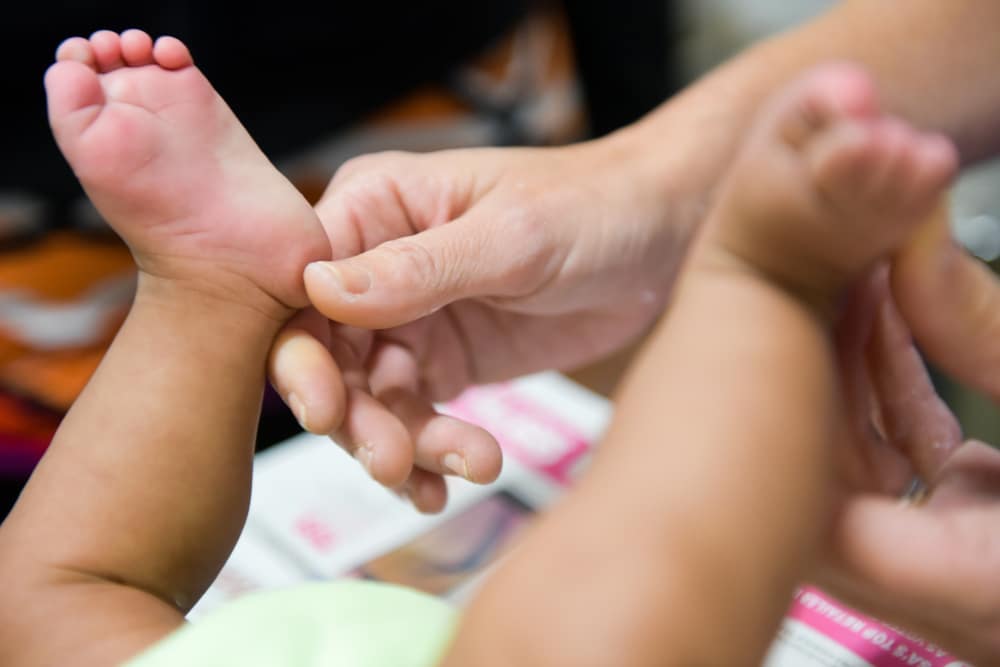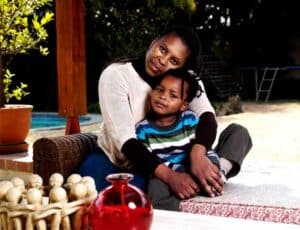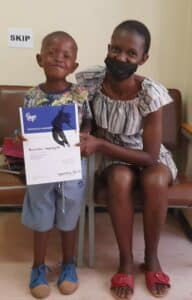Questions to find out if your doctor is using the Ponseti Method
Some doctors say that they are using the Ponseti Method, but they may be referring to the fact that they do serial plaster casts, or they may have modified the technique. Research has shown that the best results are achieved by following the protocol of the Ponseti Method as developed by Dr Ponseti (and this is backed by 60 year follow-ups). These are some questions you can ask, or things to note, if you are not sure that your doctor is using the Ponseti Method.
Q. Do you use half leg or full leg casts?
 A. The answer should be ‘full leg casts’. The Ponseti method uses casts up to the groin and bent at the knee at a ninety degree angle. This helps to immobilise and hold the manipulated foot in the right position so that the ligaments, tendons and skin can grow and stretch until the next cast is applied.
A. The answer should be ‘full leg casts’. The Ponseti method uses casts up to the groin and bent at the knee at a ninety degree angle. This helps to immobilise and hold the manipulated foot in the right position so that the ligaments, tendons and skin can grow and stretch until the next cast is applied.
Q. How many casts do you need to do before the foot is corrected?
A. The answer should be three to six casts – and maybe a couple more if the clubfoot is very severe and stiff, or the baby started the treatment when older. If it takes longer than nine casts, there is a good chance that the manipulation is not being done correctly. Dr Ponseti said that casting will not have good results in less than 5% of all clubfoot babies.
If your doctor seems vague even after one or two casts about how many more casts are needed, or tells you to “be patient”, it is likely they are not following the method correctly. You should also be able to visibly see progress by the shape and angle of the casts.
Q. Do you do a tenotomy in most cases?
 A. The answer is likely to be “Yes”, studies show this is needed in over 80% of cases. The final cast is usually after a tenotomy is done. This is done in most cases and is the only invasive part of the standard Ponseti treatment. It is typically a procedure done in the surgeon’s rooms under local anaesthetic. Some surgeons prefer to use general anaesthesia. Either way, it only takes about 10 to 15 minutes.
A. The answer is likely to be “Yes”, studies show this is needed in over 80% of cases. The final cast is usually after a tenotomy is done. This is done in most cases and is the only invasive part of the standard Ponseti treatment. It is typically a procedure done in the surgeon’s rooms under local anaesthetic. Some surgeons prefer to use general anaesthesia. Either way, it only takes about 10 to 15 minutes.
The surgeon first anaesthetises the area, then makes a tiny cut with a scalpel at the back of the heel, the Achilles tendon is cut, so that the heel drops down. The final cast is then applied to hold the foot correctly until the Achilles tendon regenerates in the correct position, which takes three weeks. There may be a little bleeding on the cast at the heel area, which looks worse than it is because the plaster acts like a sponge. All you can see afterwards is a tiny scab, the size of a pinhead, which falls off, there is no scar.
Dr Ponseti used the tenotomy because the Achilles heel is thick and resistant to stretching; he preferred to do it instead of keeping the baby in casts for longer until the tendon is fully stretched. The tendon must be stretched for the foot to be fully corrected and to be able to wear the brace comfortably. Once the final cast is removed, the clubfoot brace is fitted to help hold the correction and stretch of the Achilles tendon/heel cord.
Important note: The procedure used in the Ponseti technique is referred as a Percutaneous Tenotomy. An Open Incision or Z-lengthening Tenotomy or Heel Cord Lengthening is a very different procedure – usually unnecessary and a more invasive type of surgery that results in scar tissue.
Q. What method of splint/brace do you use?
A. The answer should be a clubfoot brace or foot abduction brace. This is a pair of open-toed shoes attached to a spreader bar at a specific angle.
Probably the best known is the brace that was designed in consultation with Dr Ponseti, the Ponseti AFO*, also known as the Mitchell Brace. This is an aluminium adjustable bar, on which two shoes are attached. The shoes will be set at a 60 º – 70º angle. If the baby only has one clubfoot, the shoe for the normal foot can be set at a 30 º to 40º angle. It may look wide to you, but it’s comfortable for the baby that way. Dr Ponseti says that the distance between the heels should equal the width of the shoulders; this is the most comfortable for the baby. The foot is over-corrected at first to allow for the ligaments, tendons and skin to grow. Other braces do the same, and there are quite a few products available depending on where you live. As long as the set-up of the brace is the same, they will work the same way.
* The Ponseti Ankle Foot Orthotic (AFO) is very different to a typical AFO, which is a plastic and velcro splint not attached to a bar. The similarity in name can be confusing. The only time that an AFO might be used with the Ponseti Method would be in some clubfoot cases where there is spina bifida, cerebral palsy or other neurological conditions, or for older children.
Q. How long is the brace worn for?
A. The answer should be initially two to three months of full time wear (23 hours a day), followed by night and naptime wear that reduces gradually from 20 to about 14 hours by the time the child is weight-bearing/cruising. By the time the child is two, brace wear is typically 10-12 hours at night until about four years of age. In a few cases, if child is hypermobile (‘double’jointed) brace wear might be stopped earlier, but it is generally recommended that they stay in it at least until four years old. Dr Ponseti’s experience was that there is a high tendency for relapse between the age of two and two and a half years of age, probably because of growth spurts. It’s important that the doctor follows the bracing protocol and assists you in the first few weeks of your baby adapting. If you follow the brace wear as prescribed in the Ponseti Method, you have a much better chance of avoiding recurrence in the majority of clubfoot cases.
Q. Is the cast applied with an assistant in attendance?
A. The answer should be “Yes”. Dr Ponseti’s method is to have one person who can apply a cast (nurse, physio, orthotist, etc) roll on the bandage while the other person continues to hold and manipulate the foot in the position required for the particular cast. The parent can help keep the baby amused and distracted while the cast is being applied. One very successful way is to feed your baby. The Ponseti method is never painful for the baby, but they may cry because they get irritated about being held still during the process. If your baby is so upset that accurate casting is made impossible, Dr Ponseti advised that the doctor stops for a few minutes to calm the baby before continuing with the cast.
Q. How often do you change the cast?
A. The cast only needs to be on for five to seven days (with the exception of the final cast if a tenotomy has been done). Not only is it not necessary to keep a cast on for any longer than that, some babies grow so fast they can literally outgrow them in a short space of time. For older children having more casts if the foot is starting to turn in, doctors may decide to leave the cast on for two weeks.
Q. When and how is each cast removed?
A. The cast should only be removed on the morning that the new one is going to be applied, not the night before. A small baby grows so quickly it can only take a few hours for relapse to start. Some doctors ask you to wet the cast and wrap in a damp towel covered with plastic, and will remove it in their rooms. Others might not have the facilities and will ask you to remove it yourself. This is not ideal, but if it’s what your doctor requires, then do it only just before you leave home. Leaving the casts off overnight means slower progress in correction and the risk of more casts.
Q. What is your success rate?
A. According to published studies, the typical success rate of Ponseti method casting is 90% (or better), if the Ponseti Method is followed without any modifications. Parents play a major part in the success figures and should follow correct brace wear protocol as prescribed to help avoid recurrence. A percentage of children with more resistant clubfoot will have recurrence. Best practice agreed by Ponseti doctors is to redo casting, and then a tendon transfer of the tendon Anterior Tibialis (TATT). This is not as invasive as the postero-medial release (PMR) and is like having an internal splint. This is only usually done around age 3 and the clubfoot brace does not need to be worn after the procedure.
Doctors around the world are publishing similar results. The proof is out there and what the successful doctors have in common is they establish clubfoot clinics with the same protocols as Dr Ponseti. They don’t deviate from the method.







